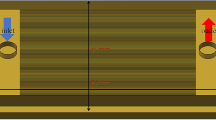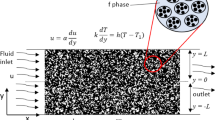Abstract
A numerical investigation is carried out to study fluid flow and heat transfer characteristics of conjugate mixed convection from a two dimensional horizontal channel with four protruding heat sources mounted on one of the finite thick channel walls. The flow is assumed as laminar, hydrodynamically and thermally developing. Water and FC70 are the fluids under consideration. The geometric parameters such as spacing between the channel walls (S), size of protruding heat sources (Lh×th), thickness of substrate (t) and spacing between heat sources (b) are fixed. Results are presented to show the effect of parameters such as Re S , Gr * S , Pr, kp/kf and ks/kf on fluid flow and heat transfer characteristics. Using the method of asymptotic expansions, correlations are also presented for the maximum temperature of heat source.










Similar content being viewed by others
Abbreviations
- A :
-
Aspect ratio, L/S
- b :
-
Spacing between the heat sources, m
- c :
-
Specific heat, J/kg K
- g :
-
Acceleration due to gravity, 9.81 m/s2
- Gr * S :
-
Modified Grashof number, based on volumetric heat generation, gβ ΔTrefS3/ν2
- Gr:
-
Grashof number defined with wall temperature, gβ(TH−TC)L 3c /ν2
- k :
-
Thermal conductivity, W/mK
- Lh, th:
-
Width and height of the protruding heat source, respectively, m
- Lc, tc:
-
Height and thickness of the cavity wall, respectively, m
- L :
-
Length of the channel walls, m
- Nuavg:
-
Average Nusselt number based on Lc, \(\int_0^1 {{\text{Nu}}_Y {\text{d}}Y} \)
- Nu Y :
-
Local Nusselt number based on Lc, −(∂θ/∂X)X=0
- p :
-
Pressure at any location in the computational domain, Pa
- P :
-
Non-dimensional pressure at any location in the computational domain
- Pe S :
-
Peclet number based on S, u∞S/α
- Pr:
-
Prandtl number, ν/α
- q v :
-
Volumetric heat generation from the protruding heat sources, W/m3
- Re S :
-
Reynolds number based on S, u∞S/ν
- Ri * S :
-
Modified Richardson number based on S, (Gr * S /Re 2 S ) or \((g\beta \Delta T_{{\text{ref}}} S/u_\infty ^2 )\)
- S :
-
Spacing between the channel walls, m
- t′:
-
Time, s
- t :
-
Thickness of the plate, m
- T :
-
Temperature, K
- u :
-
Horizontal velocity, m/s
- U :
-
Non-dimensional horizontal velocity, u/u∞
- v :
-
Vertical velocity, m/s
- V :
-
Non-dimensional vertical velocity, v/u∞
- x,y:
-
Horizontal and vertical distances, respectively, m
- X,Y:
-
Non-dimensional horizontal and non-dimensional vertical distances, x/S, y/S, respectively
- α:
-
Thermal diffusivity of the fluid, m2/s
- β:
-
Isobaric cubic expansivity of the fluid, −1/ρ(∂ρ/∂T) P , 1/K
- δ:
-
Convergence criterion, in fractional form, |(φnew−φold)/φnew|
- ɛ1,ɛ2,ɛ3,ɛ4,ɛ5:
-
Parameters in the asymptotic expansion
- φ:
-
Any variable (U, V or θ), over which convergence is being tested for
- ν:
-
Kinematic viscosity of fluid, m2/s
- θ:
-
Non-dimensional temperature at any location in the computational domain, (T−T∞)/ΔTref or (T−TC)/ΔTref
- ρ:
-
Density of the fluid, kg/m3
- τ:
-
Non-dimensional time, u∞t’/S
- ψ:
-
Non-dimensional stream function, U=∂ψ/∂Y, V=−∂ψ/∂X
- c:
-
Cavity
- C:
-
Cold
- f:
-
Fluid
- h:
-
Heat source
- H:
-
Hot
- max:
-
Maximum
- new, old:
-
Values of the dependent variables (U, V, θ) obtained from the present and previous iterations
- p:
-
Protruding heat source
- ref:
-
Reference value
- s:
-
Substrate
- ∞:
-
Ambient
- ΔTref:
-
Reference temperature difference, (qvLhth/kf) or (TH−TC), K
References
Davalath J, Bayazitoglu Y (1987) Forced convection cooling across rectangular blocks. ASME J Heat Transfer 109:321–328
Kim SH, Anand AK (1994) Laminar developing flow and heat transfer between a series of parallel plates with surface mounted discrete heat sources. Int J Heat Mass Transfer 37:2231–2244
Young TM, Vafai K (1998) Convective flow and heat transfer in a channel containing multiple heated obstacles. Int J Heat Mass Transfer 41:3279–3298
Furukawa T, Yang W (2003) Thermal-fluid flow in parallel boards with heat generating blocks. Int J Heat Mass Transfer 46:5005–5015
Brateen EM, Patankar SV (1985) Analysis of laminar mixed convection in shrouded array of heated rectangular blocks. Int J Heat Mass Transfer 28:1699–1709
Kim SY, Sung HJ, Hyun JM (1992) Mixed convection from multi-layered boards with cross-stream wise periodic boundary conditions. Int J Heat Mass Transfer 35:2941–2952
Heindel TF, Incropera FP, Ramadhyani R (1992) Liquid immersion cooling of longitudinal array of discrete heat sources in protruding substrates: 1. Single phase forced convection. J Electronic Packaging 114:55–62
Mahaney HV, Incropera FP, Ramadhyani S (1990) Comparison of predicted and measured convection heat transfer from an array of discrete sources in a horizontal rectangular channel. Int J Heat Mass Transfer 33:1233–1245
Sathe SB, Joshi Y (1992) Natural convection liquid cooling of a substrate-mounted protrusion in a square enclosure: a parametric study. ASME J Heat Transfer 114:401–409
Herwig H (1985) Effect of variable properties on momentum and heat transfer in a tube with constant heat flux across the wall. Int J Heat Mass Transfer 28:424–431
Herwig H, Voigt M, Bauhaus FJ (1989) The effect of variable properties on momentum and heat transfer in a tube with constant wall temperature. Int J Heat Mass Transfer 32:1907–1915
Balaji C, Herwig H (2003) The use of ACFD approach in problems involving surface radiation and free convection. Int Commun Heat Mass Transfer 30:251–259
Patankar SV (1980) Numerical heat transfer and fluid flow. Hemispere, New York
Aung W, Worku G (1986) Developing flow and flow reversal in a vertical channel with asymmetric wall temperatures. ASME J Heat Transfer 108:299–304
Kaminski DA, Prakash C (1986) Conjugate natural convection in a square enclosure: effect of conduction in one of the vertical walls. Int J Heat Mass Transfer 29:1979–1988
Author information
Authors and Affiliations
Corresponding author
Rights and permissions
About this article
Cite this article
Premachandran, B., Balaji, C. Mixed convection heat transfer from a horizontal channel with protruding heat sources. Heat Mass Transfer 41, 510–518 (2005). https://doi.org/10.1007/s00231-004-0570-0
Received:
Accepted:
Published:
Issue Date:
DOI: https://doi.org/10.1007/s00231-004-0570-0




